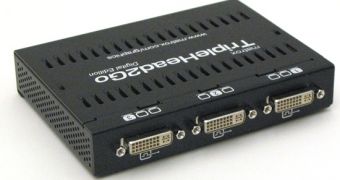Dual monitors setups have become a common thing among the advanced PC users. These setups are easy to achieve using a simple video card that comes with a pair of monitor outputs (most of them feature a VGA/DVI combination). Moreover, there are even single monitors equipped with dual displays, such as Samsung's 2263DX 22-inch model.
What can we do when two monitors are not enough and we need to add a third one? This kind of setup is not quite easy to achieve if not using a high-end video card, but Matrox makes sure you are surrounded by as many monitors as you need to increase your productivity.
The idea behind the TripleHead2Go is not new at all, since the product was released back in 2006. Although it can support three displays without any problems, it has one major shortcoming: it's analog VGA only. The new version of the DualHead2Go and TripleHead2Go is based on the same principle as before, only that this time it runs using DVI connections, instead of analog VGA.
The digital version of the TripleHead2Go accepts either dual-link DVI or VGA inputs. The unit itself is powered via an USB bus, so there is no need for another adapter plugged into your wall sockets. The input signal is taken from a DVI-enabled video card, and is passed on to three other DVI outputs.
As I said before, the concept is pretty simple: take a single DVI connection and split it into three. However, more picky users will find its unpleasant limitations: you can use either three 1280x1024 or two 1920x1200 monitors, but not three 1920x1200 pieces, because of the bandwidth limitation in the dual-link DVI (it can only carry 3840x1024).
Matrox's gadget is interesting as proof of concept, but it can hardly be put to work and be called efficient. For $329 you can buy two mid-range video cards, join them into a SLI or CrossfireX link and run much more displays than TripleHead2Go can even imagine.

 14 DAY TRIAL //
14 DAY TRIAL //